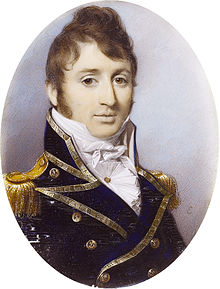Sir Charles Malcolm
|
Sir Charles Malcolm |
|
|---|---|

Charles Malcolm, by George Engleheart
|
|
| Born |
5 September 1782 Burnfoot, Dumfriesshire |
| Died | 4 June 1851 (aged 68) Brighton |
| Allegiance | Great Britain |
| Service/branch | Navy |
| Years of service | 1795-1819 |
| Rank | rear-admiral 10 January 1837; vice-admiral 28 April 1847 |
| Commands held |
Albatross; Eurydice; Raisonnable; Narcissus; Rhin; Sibylle |
Sir Charles Malcolm (1782–1851) was a Scottish Royal Navy officer, who reached the rank of vice-admiral.
He was the tenth son of George Malcolm of Burnfoot, youngest brother of Sir Pulteney Malcolm and Sir John Malcolm, and was born at Burnfoot in Dumfriesshire on 5 September 1782. In 1791 his name was put on the books of the Vengeance, commanded by his uncle, Thomas Pasley, and in 1793 of the Penelope, of which his brother Pulteney was first lieutenant. He entered the Navy in 1795 on board the Fox, then commissioned by his brother, with whom he went out to the East Indies, and whom he followed to the Suffolk. He was promoted by the admiral to be lieutenant on that ship, 12 January 1799, and remained in her till 3 October 1801, when he was appointed acting commander of the Albatross sloop, a promotion which was confirmed by the admiralty to 28 May 1802.
In 1803, Malcolm came home acting captain of the Eurydice, and on his arrival in England found that he had been previously promoted by the admiralty on 29 December 1802. In 1804 he commanded the Raisonnable in the North Sea; and from 1806 to 1809 the Narcissus frigate, actively employed on the coast of France and Portugal; at Oporto in 1807 he was able to preserve British property from falling into the hands of the French.
At the beginning of 1809, Malcolm went out to the West Indies, and in April took part in the capture of the Saintes islands. On his return to England he was moved into the Rhin, in which during 1812 and 1813, he was employed in co-operating with the patriots on the north coast of Spain. In 1813, he went out to the West Indies with convoy; in 1814, he was cruising on the coast of Brazil; and on 18 July 1815, having been joined by the frigates Menelaus and Havannah, sloops Fly and Ferret, and schooner Sealark, he landed a party of seamen and marines at Corrijou (Koréjou, east of Abervrach on the coast of Brittany), stormed the battery, and brought out of the harbour three small armed vessels and a convoy under their protection. The action was the last of its kind during that war.
...
Wikipedia
